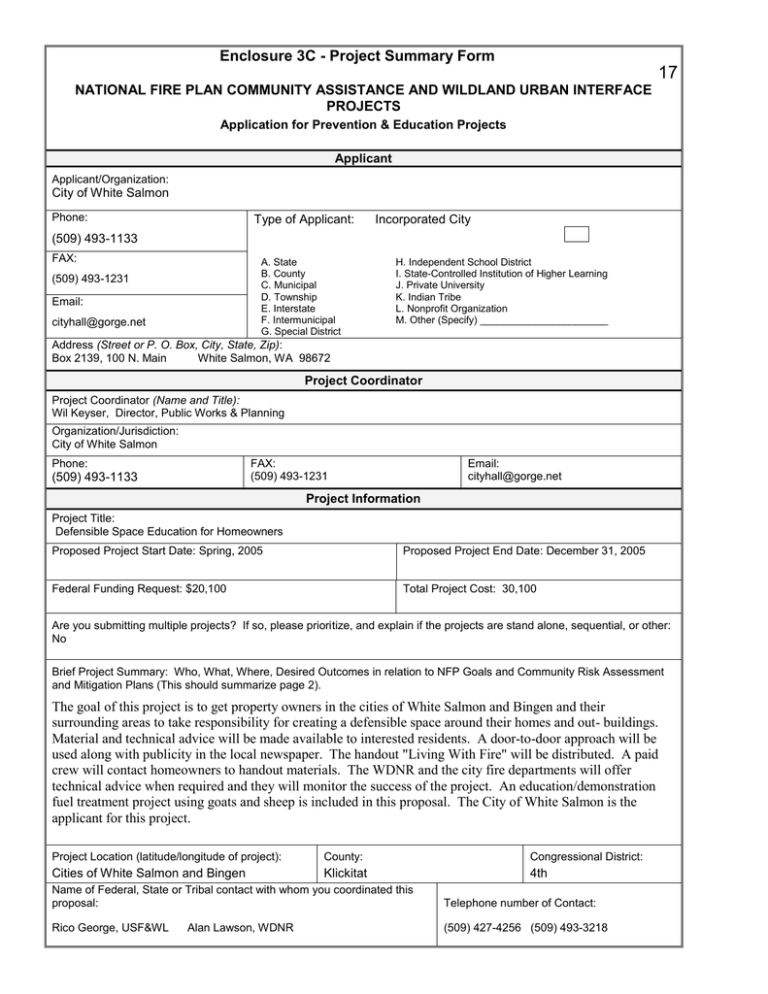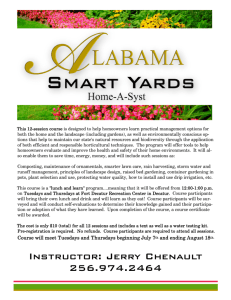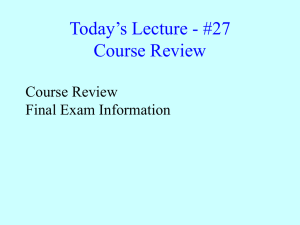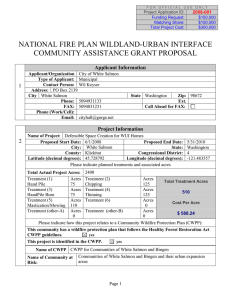17 Enclosure 3C - Project Summary Form
advertisement

Enclosure 3C - Project Summary Form 17 NATIONAL FIRE PLAN COMMUNITY ASSISTANCE AND WILDLAND URBAN INTERFACE PROJECTS Application for Prevention & Education Projects Applicant Applicant/Organization: City of White Salmon Phone: Type of Applicant: Incorporated City (509) 493-1133 FAX: A. State B. County C. Municipal D. Township E. Interstate F. Intermunicipal G. Special District (509) 493-1231 Email: cityhall@gorge.net H. Independent School District I. State-Controlled Institution of Higher Learning J. Private University K. Indian Tribe L. Nonprofit Organization M. Other (Specify) _______________________ Address (Street or P. O. Box, City, State, Zip): Box 2139, 100 N. Main White Salmon, WA 98672 Project Coordinator Project Coordinator (Name and Title): Wil Keyser, Director, Public Works & Planning Organization/Jurisdiction: City of White Salmon Phone: FAX: (509) 493-1231 (509) 493-1133 Email: cityhall@gorge.net Project Information Project Title: Defensible Space Education for Homeowners Proposed Project Start Date: Spring, 2005 Proposed Project End Date: December 31, 2005 Federal Funding Request: $20,100 Total Project Cost: 30,100 Are you submitting multiple projects? If so, please prioritize, and explain if the projects are stand alone, sequential, or other: No Brief Project Summary: Who, What, Where, Desired Outcomes in relation to NFP Goals and Community Risk Assessment and Mitigation Plans (This should summarize page 2). The goal of this project is to get property owners in the cities of White Salmon and Bingen and their surrounding areas to take responsibility for creating a defensible space around their homes and out- buildings. Material and technical advice will be made available to interested residents. A door-to-door approach will be used along with publicity in the local newspaper. The handout "Living With Fire" will be distributed. A paid crew will contact homeowners to handout materials. The WDNR and the city fire departments will offer technical advice when required and they will monitor the success of the project. An education/demonstration fuel treatment project using goats and sheep is included in this proposal. The City of White Salmon is the applicant for this project. Project Location (latitude/longitude of project): County: Congressional District: Cities of White Salmon and Bingen Klickitat 4th Name of Federal, State or Tribal contact with whom you coordinated this proposal: Telephone number of Contact: Rico George, USF&WL (509) 427-4256 (509) 493-3218 Alan Lawson, WDNR Enclosure 3C (Page 1 of 3) - Project Narrative Description Applications for funding must include a narrative response that describes the proposal. Please do not submit responses longer than one page, single space, and 12-pitch font. Describe project, including, but not limited to: type of project to be delivered project location method of delivery project relationship to community or natural landscape fire plans target audience timeliness tools and/or skills needed to complete project projected timelines and cost estimation monitoring and evaluation procedures For this project, explain the level of cooperation, coordination or strategic planning, through a “Local Coordination Group.” If you haven’t worked with a local coordination group, why not? This project involves the education of homeowners about hazardous fuel situations and methods to reduce the potential for catastrophic wildfire, which could threaten human lives and private property in their community. It involves homeowners in the cities of White Salmon and Bingen, and on lands in the vicinity of these communities. The objective of the project is to inform homeowners about situations which could lead to dangerous wildfire events, and about what they can do to reduce the potential for this to happen. Response: Project objectives would be accomplished with the help of paid staff and volunteers who would go door-todoor delivering materials and discussing how landowners could accomplish hazardous fuel reduction on their property, and how they could develop a defensible space around their homes. Additionally, community workshops may be offered to augment the education process. The target audience would be those homeowners located in areas identified as high priority through the community fire planning process. A Community Wildfire Prevention Plan for the White Salmon-Bingen and surrounding area will be completed during the spring-summer of 2004. The community plan will include an assessment of fuel situations and a fire risk rating of residents in high priority areas. Handouts such as "Living With Fire" will be given to homeowners. Paid staff and volunteers will be trained by the DNR so they are well qualified to discuss fire risks and methods to reduce hazardous fuels and other wildfire risks. The project will begin as soon as funds are ready which would be the spring of 2005 at the earliest. It is estimated the project will require $22,100 to complete plus in-kind $10,000support from several partners. Fire Department personnel from White Salmon and Bingen, as well as the DNR will monitor how the project is being conducted and will evaluate its success. Criteria for success will be measured in accomplishments by homeowners in reducing hazardous fuel situations on their property. A fuel reduction demonstration project is a part of this proposal. A test area will be identified on the White Salmon bluff area and goats and sheep will be used to determine their effectiveness in reducing hazardous fuels. The bluff area is steep and access is difficult. Heavy fuels exist including conifers, hardwoods and lots of poison oak. Wildfires beginning near Highway 14 or the adjacent railroad typically race to the top of the bluff. More than 250 homes are at risk from bluff fires and the cities of White Salmon and Bingen want to find a cost-effective means of treating fuels so that fires that do occur will be easier to control. Goats and sheep have been effectively used in several areas in the Pacific Northwest to reduce hazardous fuels. Officials from the City of White Salmon met with representatives of the Local Coordinating Group for this area prior to completing a draft application. Several options for a NFP grant were discussed at the meeting and the best approach to use given the situation in the White Salmon - Bingen area. They then attended a Local Coordination Group meeting on January 27 in Stevenson and presented a draft application for their review. The Local Coordination Group evaluated the proposal and gave advice for modifying it. Enclosure 3C (Page 2 of 3) - Project Evaluation Criteria 1. Prevention of Wildland Urban Interface Fire (40 points) Describe how the proposal will lead to: A. Reduction of wildland urban interface fire B. Reduction of structural losses C. Homeowner action and personal responsibility to reduce fire loss of private land. Response: This project is designed to help homeowners in the project area take responsibility for reducing the risk of catastrophic wildfire in their neighborhoods. The project may reduce the number of wildfires in the project area by making homeowners aware of human activities, which could start a wildfire. Importantly, it will reduce the risk of a catastrophic fire that could threaten large numbers of structures and lives. The objective is to get homeowners to create a defensible space by reducing the level of hazardous fuel loads around their homes and associated structures. This in turn would give fire suppression crews a better opportunity to take effective action during a wildfire event to protect lives and property. High priority areas identified by the Washington DNR will be canvassed by paid staff and volunteers who will give information and advice on how homeowners can help develop a defensible space around their property. Technical advice from White Salmon and Bingen City Fire Departments and the DNR fire crews will be available for homeowners who wish to participate. Homeowners will participate on a volunteer basis. Project partners will follow-up with participating homeowners to verify that the goal of providing a defensible space has been achieved, or what is still needed to reach the goal. The fuel reduction demonstration project will educate city officials and residents as to the effectiveness of using goats and sheep for reducing hazardous fuels in the difficult to access, bluff area. A 10 to 20 acre test area representative of the fuel situation on the bluff will be selected and a goat herder will be hired to place goats and sheep there in the summer of 2005 for a test. This total proposal emphasizes the education of property owners so they have the information for, and an understanding of, the need to take responsibility for creating a defensible space around their homes and out-buildings. It is designed to give residents the needed tools to initiate and continue in the future, fuel reduction measures in their back yard. Enclosure 3C (Page 3 of 3) - Project Evaluation Criteria 2. Community Participation (30 points) Detail the community participation and collaboration for this project. Define clearly why you believe your group will be successful in delivering the proposal to the target audience. How will the project be sustained or carried forward beyond project timelines? How will the project be monitored and evaluated? Response: The overall goal for this project is to convince homeowners it is in their best interests to take measures to reduce hazardous fuel situations on their property. Many residents already understand the importance of developing a defensible space around their structures and are ready to take action. Others may need encouragement and advice to become motivated to get the job done. Some homeowners may choose to ignore the problem. To be successful, this project envisions a one-on-one approach to deliver a message to homeowners. Paid staff and volunteers will meet interested homeowners on their property and deliver information and ideas on how to get started and what is needed to accomplish the goal. While some property owners may not be interested in participating initially, some of these may be influenced by actions of their neighbors and eventually decide to participate themselves. A steering/coordinating committee (see #3 below) will monitor and evaluate the success of this project. The city fire departments and the Washington DNR are organizations that will continue to have an interest and involvement in the goal of this project after it is complete. They will be available to continue to assist homeowners beyond the project timeline. The project will be monitored by volunteers from the NW Service Academy and evaluated by the WDNR and city fire department officials. If it is determined that the use of goats and sheep is cost effective in reducing hazardous fuels on the bluff, this practice could become the preferred method of control in the future. City officials will then explore ways to have affected property owners pay an annual fee to continue this type of fuel reduction method. 3. Partnerships (40 points) Detail the level of involvement of any local multi-agency, emergency services, non-profit coordination group, and provide a list of partners for this project with their current and expected level of involvement, including any kind of contributions or matching funds. What is the project relationship to a community risk assessment or mitigation plan? Include the name of the plan, date it was prepared, and local contact to get a copy of the plan if requested. Response: The Cities of White Salmon and Bingen will complete a Community Wildfire Prevention Plan in the spring/summer of 2004 with the aid of Title III grant dollars from Klickitat County. This plan will be developed with the assistance of representatives from: Cities of White Salmon and Bingen including both fire departments, Klickitat County, Washington Department of Transportation, Washington Department of Natural Resources, the Underwood Soil Conservation District, Extension Service, NW Service Academy, USDA Forest Service, and interested land-owners. Some or all of these partners will give guidance for this homeowner education project. A coordination or steering committee will be formed from this mix of planning representatives. Several coordination meetings will be held to gather input from participating partners. The Washington DNR will help identify high priority areas within the project area to concentrate efforts. They and the city fire departments will be the primary source of technical advice for accomplishing fuel reduction measures on private property. Further, they will monitor progress of fuel reduction projects by homeowners. Landowners who choose to participate in this volunteer program will be given assistance by these organizations. The NW Service Academy will assist senior citizens, low income and disabled persons accomplish fuel reduction measures on their properties. They will also help the WDNR and the Underwood Soil Conservation District monitor and evaluate the fuel reduction demonstration project. Volunteers will include volunteer city fire department members and interested citizens. Enclosure 3C - Project Work Form Tasks Order "Living With Fire" handouts Hire two person crew Train crew Contract for supervision Contact Contacthomeowners homeowners Provide Providetechnical technicaladvice advice Monitor Monitorhomeowner homeownerprogress progress Supervise Supervisecrew crew Time Frame April, 2005 April 2005 May1, 2005 May 1, 2005 May 10,May 2005 10, 2005 May 1, May 20051, 2005 Responsible Party WDNRWDNR City of White City ofSalmon White Salmon WDNR,WDNR, City FireCity Departments Fire Departments City of White City ofSalmon White Salmon May 15May to September 30, 2005 15 to September 30, 2005Two person Two crew person crew May 15May to September 30, 2005 City FireCity Departments 15 to September 30, 2005WDNR,WDNR, Fire Departments June 1 to December 31, 2005 City FireCity Departments June 1 to December 31, 2005 WDNR,WDNR, Fire Departments May 15May to September City Contractor 15 to Sept.30, 30,2005 2005 City contractor Publicity Newspaper, radio May 1 to September 30, 2005 Publicize–project in newspaper May 1 to September 30, 2005 City Contractor City Contractor Conduct one or more workshops Workshops May 1 to September 30, 2005 May 1 to September 30, 2005 City Contractor City Contractor Identifyhigh high priority priority areas Identify areas May 1 to June 1, 2005 WDNR May 1 to June 1, 2005 WDNR Schedulecommittee and facilitate 3 steering Steering meetings (3)committeeMay 1 to September 30, 2005 May 1 to September 30, 2005 Contractor Contractor meetings Select fuel reduction demonstration area Obtain landowner permission May, 2005 WDNR April, 2005 City of White Salmon Contract for goat/sheep herd use. May 2005 City of White Salmon Administer contract June – Sept., 2005 City of White Salmon Monitor and evaluate results June – October, 2005 WDNR Underwood Soil Conservation District NW Service Academy Enclosure 3D Project Budget Cost Category Description Federal Agency Personnel Applicant Partner 1 Partner 2 NFP City of White Salmon Underwood Soil NW Service Academy $12,000 150 man-days@$80 Total WDNR Subtotal Fringe Benefits Subtotal Travel 3000 miles@.35 $1050 Subtotal Equipment Handouts-Living With Fire 5000 Subtotal $550 Supplies Subtotal Contractual Supervision Goats/sheep $2,500 $4,000 Subtotal Other In Kind Support $3,000 $2,000 $2,000 $2,500 $3,500 $2,000 $2,000 $2,500 Subtotal Total Costs $20,100 Project (Program) Income1 (using deductive alternative) 1 Program income is the gross revenue generated by a grant or cooperative agreement supported activity during the life of the grant. Program income can be made by recipients from fees charged for conference or workshop attendance, from rental fees earned from renting out real property or equipment acquired with grant or cooperative agreement funds, or from the sale of commodities or items developed under the grant or cooperative agreement. The use of Program Income during the project period may require prior approval by the granting agency.




